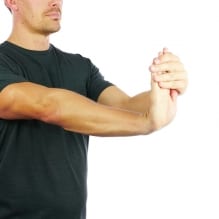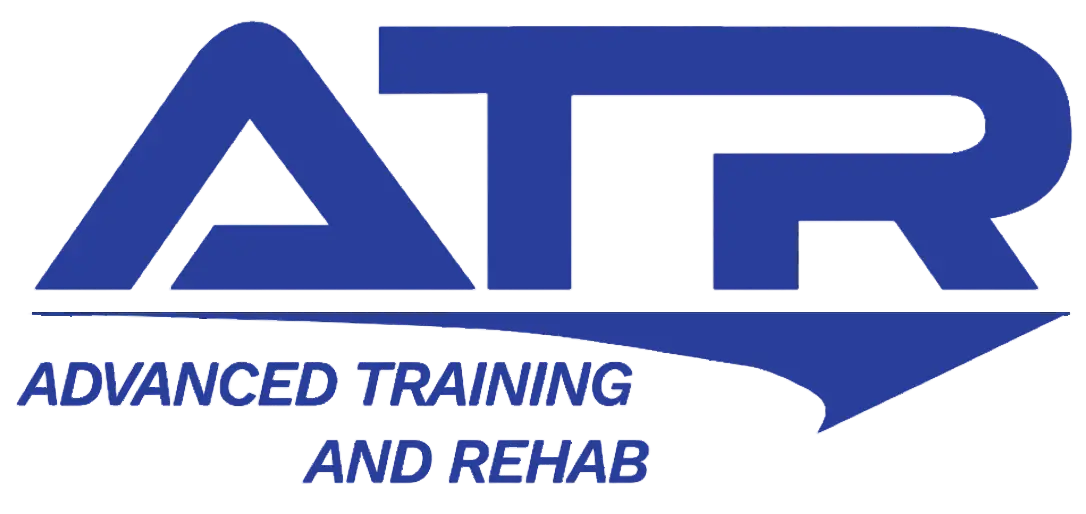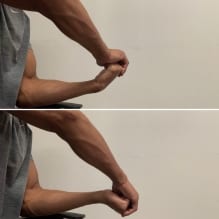Medial Epicondylitis (Golfer’s elbow)

What is it?
Medial epicondylitis, or golfer’s elbow, is a common condition that occurs when the flexor tendons of the forearm become irritated and inflamed where they attach to the elbow. These flexor muscles act to bend the wrist, bringing the palm of the hand towards the forearm. Pain is felt on the inside of the elbow, closest to the body. There can be many reasons that these tendons become inflamed, but the most common reasons are overuse, repetitive wrist flexion (swinging a golf club, forehand in tennis, etc), and repetitive gripping activities.
Who Gets It?
Medial epicondylitis is an overuse injury of the flexor tendon, so athletes of all levels commonly experience this condition. However, you do not have to be an athlete to experience medial epicondylitis. Any occupation or recreational activity that requires a lot of gripping and lifting can lead to inflammation of these tendons. A sudden increase in the number of times one is gripping or flexing the wrist can also cause this condition. This condition is most commonly seen in young to middle age adults who recreationally golf, play tennis, or throw overhead.
Symptoms
- Pain and tenderness on the inside of the elbow
- Increased pain with repetitive movement
- Pain with repetitive motions such as golfing, a forehand in tennis, or overhead throwing
- Swelling or inflammation of the inside of the elbow
- Weakness of the wrist flexors
- Numbness of the ring and pinky fingers
How Will It Be Diagnosed?
Your healthcare provider will be able to diagnose medial epicondylitis based upon your clinical symptoms, health history, and a physical exam. Because medial elbow pain can be caused by a variety of structures, a physical examination is important to rule out other causes. Imaging such as an x-ray or an MRI is not typically necessary to diagnose this condition.
How Is It Treated?
Medial epicondylitis is typically treated with conservitive measures. During the initial onset of medial epicondylitis, treatment consists of rest, activity modification, and modalities in order to reduce symptoms and manage pain. Due to the repetitive overuse nature of medial epicondylitis, it is important to avoid repetitive wrist flexion, gripping, and any other painful movements to allow the flexor tendon to heal and to decrease inflammation. After the acute phase, focus is switched to improving ROM and correcting imbalances of flexibility and strength.
Exercises
There are many exercises you can perform to help relieve pain caused by medial epicondylitis. Exercise will focus on improving imbalances in flexibility and strength of the muscles of the forearm and wrist. Exercise will also focus on strengthening surrounding muscles for improved muscle function and tolerance to activity. A little pain is acceptable with these exercises, but should not exceed a 3-4/10 rating.
Wrist extension stretch

Stand with your arm extended at shoulder height, palm down facing the floor. Using your other hand, gently pull back on the fingers towards your wrist until a light stretch is front through the underside of the forearm and elbow. For a stronger stretch rotate the arm so the fingers face the ground and pull towards the forearm. Hold this stretch for 20 seconds, repeating 3-5 times. We recommend performing this stretch 3-5 times per day as tolerated
Wrist flexion eccentric
Sit with your forearm resting on a table or firm surface with your hand off of the end of the table palm up. Bring the palm of your hand up towards your forear
m. With your other hand, press your hand back towards the ground. Resist this force with the original hand, but allow the hand to slowly lower towards the ground. Repeat this 10-12 reps for 2-3 sets or until fatigue.
Resisted supination and pronation- (with a hammer, etc)
Sit with your forearm resting on a table or firm surface with your thumb pointing towards the ceiling. Hold a hammer or similar object in your hand and lower it slowly to the right, then all the way to the left. Repeat this 10 times to each side for 2-3 sets or until fatigue.
Medial epicondylitis and Physical Therapy
Physical therapy can assist with improving symptoms of medial epicondylitis and help with return to functional activities. Physical therapists and physical therapist assistants will use a variety of interventions to reduce pain and inflammation, such as cold packs, electrical stimulation, manual therapy, ultrasound, and stretching, as well as provide education on activity modification. After the acute phase, your therapist will guide you through exercises to improve imbalances in muscle flexibility and strength. As symptoms improve, your therapist will include functional training to help you safely return to your previous functional activities. Your ATR physical therapy team will create an individualized and dynamic program using a variety of tools to assist in return to desired activities.
Authors: Jeff Bell, MPT, John Sandman, DPT, CSCS, and Emily Kolisch, DPT






